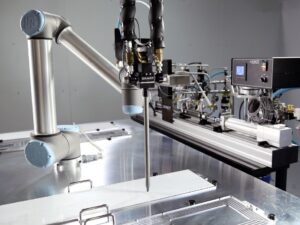Moisture Contamination with Polyurethanes
By design, plural component formulations are reactive materials. When combined at the specified ratio, they provide engineered performance characteristics to meet countless industrial and personal applications. Some chemistries have traits that may or may not be appealing in some applications.
2K Polyurethane base components are Polyol and Isocyanate. Both components are hygroscopic. They can and will absorb moisture directly from their environment unless preventative measures are taken. Condensation, humidity, etc., are typically your enemy regarding maintaining healthy formulation and product. Often the formulators will add moisture scavengers to thwart the adverse events that can occur.
Why bother?
Moisture will react with Isocyanate and generate carbon dioxide. Although this may be a desirable trait if you are looking to create foam, most bonding or potting application would like to avoid this reaction.
The first indication of moisture contamination is “cloudiness” followed by crystalline structure typically noticed on the material surface. If this occurs, it’s typically too late. There has been some success with heat and vacuum to remove the moisture and reconstitute the liquid but typically, it will require replacement. The contaminated material, in some cases can be flushed/chased from your metering system. It’s best to consult your formulator and equipment manufacturer on what is the best course of action as some chemistries can react adversely and/or your system may become damaged with inappropriate solvents or flushing materials.
What about the Polyol?
Polyol is relatively inert. It will absorb the moisture and simply “stare back at you” yet…it will carry the moisture and present it to the Isocyanate during static or dynamic mixing. The final product may cure acceptably but will usually be riddled with numerous micro-bubbles as a result of the carbon dioxide generation during the curing process. The extent of the outgassing is directly related to the amount of moisture and the sensitivity of the isocyanate.
What do I do?
- Heed your formulators and dispense equipment manufacturers advice.
- Nitrogen on your supplies is your #1 best line of defense followed by desiccant cartridges. Either a low-pressure line or a blanket of nitrogen gas will create a dry barrier between your formulation and the moisture laden air. Don’t forget your bulk container as well. If you decant partials from a drum or pail, the remainder needs to be protected from moisture. Use nitrogen before you reseal the cover. You can obtain everything you need from your local welder’s supply including a low-pressure regulator.
- Keep your supply tank volumes as full as reasonably possible. Less “empty” space means less chance of moisture laden air.
- Minimize temperature changes that can cause condensation.
- Use the material. Static material increases the chance of contamination.
Moisture contamination can be an expensive lesson to learn when it comes to dispensing equipment. The prevention is far easier in the long run and your dispensing equipment will thank you for it.




